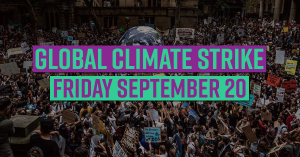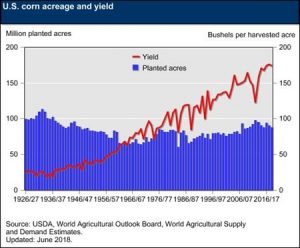Addison Smith
I find it astounding that according to the World Health Organization, 4.2 million people die every year as a result of unsafe air pollution, and 91% of people live in places where air quality exceeds the World Health’s safety standards. I find it even more astounding that there 5.25 trillion pieces of plastic debris in the ocean. The worst part about these astonishing statistics: they are completely preventable.
We have created a culture of convenience and one time usage; it is killing our world. For example, we use plastic water bottles, plastic straws, and plastic bags one time. First, the production of these items release harmful pollutants in the air that create smog and cause lung disease such as asthma, emphysema, and even cancer. After we use these items, they end up in our rivers, lakes, streams, and oceans, which cause detrimental health effects in humans, animals, and ecosystems.
While our circumstances look quite grim, there are new, promising innovations that are drastically decreasing these harmful air pollutants. For example, Daan Roosegaarde created the Smog Free Tower in 2015. This tower is much like a vacuum cleaner: it takes in unclean air, and through an ionization process, it then releases clean air back into the environment. “It can clean 30,000 cubic meters of air every hour, and it can suck in up to 70% of PM10, which are tiny pollutants that lodge in our lungs,” according to ENS Clean Air. These towers stand around 23 feet tall, and cost $54,000. They are meant to clean small spaces, like public parks and other public spaces. I believe that these vacuum towers are the keys to the future of clean air, as they have been extremely successful in large cities like Beijing and Tianjin. Now, it is time for our government to prioritize clean air and create incentives for businesses and other institutions to invest in these towers.
In the ocean, the situation seems even more grim. However, Ocean Cleanup, an organization dedicated to cleaning our water sources, has created a passive cleaning system. It is considered a passive system because it does not rely on any external forces. In fact, it relies on natural forces such as solar, wind, and current powers. These natural forces along with an anchor collect large amounts of pollutants and concentrate them in one physical location. Then, a vessel goes into the system and removes the trash, much like a typical garbage truck. According to Ocean Cleanup, this system has the capacity to remove up to 50% of the Great Pacific Garbage Patch in just five years!
These innovations are promising, and I am beyond thankful for these wonderful inventors because they very well might save us. However, as consumers, we cannot simply rely on the next innovation to save us. As previously mentioned, we have the capacity to prevent much of our water and air pollutants. It is time to create a culture that prioritizes our world over mere convenience.


Sources:
“Air Pollution.” World Health Organization, World Health Organization, 24 Sept. 2019, www.who.int/airpollution/en/.
“New Positive Results for the Smog Free Tower.” ENS Clean Air, 6 Aug. 2018, www.ens-cleanair.com/en/new-positive-results-for-the-smog-free-tower/.
“Oceans.” The Ocean Cleanup, 2016, theoceancleanup.com/oceans/.
Staff, Ng. “Ocean Trash: 5.25 Trillion Pieces and Counting, but Big Questions Remain.” National Geographic, 29 Nov. 2017, www.nationalgeographic.com/news/2015/1/150109-oceans-plastic-sea-trash-science-marine-debris/.



 Even more concerning than the additional travel time for your weekend getaway, however, is the impact of this heavy traffic on the environment. With weak (although improving!) public transportation in Greenville County and the surrounding areas, the Upstate suffers from severe automobile dependence. The automobile is simply more convenient for most residents, so Greenville citizens pile into their cars and commute to work, travel across the state, or simply zip a mile or two down the road to the grocery store. This is something I see quite often even on Furman’s campus, where students will hop in their car to go anywhere, even to simply drive to class. Although the car’s reliability may be convenient, it has some major drawbacks, including increased traffic and the obvious CO
Even more concerning than the additional travel time for your weekend getaway, however, is the impact of this heavy traffic on the environment. With weak (although improving!) public transportation in Greenville County and the surrounding areas, the Upstate suffers from severe automobile dependence. The automobile is simply more convenient for most residents, so Greenville citizens pile into their cars and commute to work, travel across the state, or simply zip a mile or two down the road to the grocery store. This is something I see quite often even on Furman’s campus, where students will hop in their car to go anywhere, even to simply drive to class. Although the car’s reliability may be convenient, it has some major drawbacks, including increased traffic and the obvious CO



 them in shopping carts or local farmer’s markets. McDonald’s and ready-made fast food options spread like a rash through these ‘food deserts,’ causing obesity, health problems, and lack of community. In the United States alone, there are at least 23 million people living in food deserts, and more than half of them
them in shopping carts or local farmer’s markets. McDonald’s and ready-made fast food options spread like a rash through these ‘food deserts,’ causing obesity, health problems, and lack of community. In the United States alone, there are at least 23 million people living in food deserts, and more than half of them  and if city residents are involved, urban agriculture can easily alleviate the effects of food deserts. Cleveland, Ohio, a city entrenched in the rust belt and prone to economic decline and depopulation, is one of several American cities who have successfully integrated urban green and agricultural space. Over the past couple decades, city legislators have
and if city residents are involved, urban agriculture can easily alleviate the effects of food deserts. Cleveland, Ohio, a city entrenched in the rust belt and prone to economic decline and depopulation, is one of several American cities who have successfully integrated urban green and agricultural space. Over the past couple decades, city legislators have 



